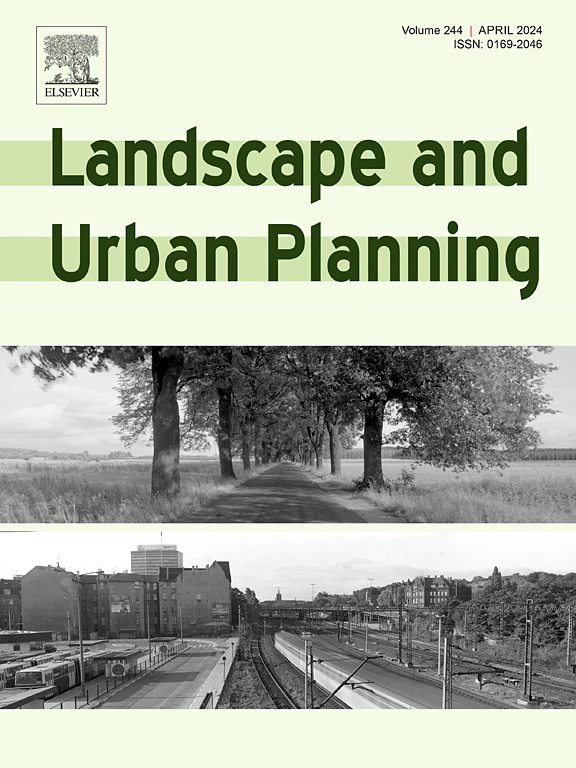Exploring the inequality in urban parks’ distribution and their cooling effects from the perspective of urbanization
IF 9.2
1区 环境科学与生态学
Q1 ECOLOGY
引用次数: 0
Abstract
Urban parks play a crucial role in mitigating urban overheating, but their unequal distribution exacerbates heat inequality. Park cooling effects extend beyond park boundaries, benefiting surrounding residential communities. However, it remains uncertain whether the spatial spillover of park cooling effects can compensate for the unequal distribution of urban parks. This study estimated the park cooling effects in 276 Chinese cities and analyzed the inequality in access to urban parks and their cooling effects across Chinese residential communities from the perspective of urbanization. The results show that: (1) Chinese urban parks provide substantial cooling effects. The average park cooling intensity (PCI) in selected cities is 1.36 °C, with a cooling distance (PCD) of 165 m and a cooling area (PCA) of 879,879 × 104 m2, accounting for 52 % of residential community areas. However, 25 % of the cooling areas overlap, and only 12 % of residential communities are covered by cooling areas directly. (2) Observed inequality in Chinese urban parks’ distribution and their cooling effects. Wealthier communities have access to smaller parks with more water bodies, less impervious surfaces, and higher PCI. Inequality exists in both park and cooling areas. However, the significantly lower Gini index of cooling areas compared to park areas suggests that enhancing park cooling effects can help mitigate the inequality in urban parks’ distribution. (3) Inequities in parks’ distribution and cooling effects vary across cities with different levels of urbanization. Chinese cities can be clustered into two types based on the inequality in urban parks and their cooling effects, highlighting the unique challenges faced by cities at different development levels. Cities with lower urbanization rate and GDP lack sufficient per capita park and cooling areas, while more urbanized and economically developed cities face more severe inequity challenges related to inequitable distribution of urban parks and their cooling effects. We recommend increasing park supply, optimizing park spatial distribution, and enhancing cooling effects to address insufficient park resources and their unequal distribution.
城市化视角下城市公园分布不均及其降温效应研究
城市公园在缓解城市过热方面发挥着至关重要的作用,但它们的分布不均加剧了热量不平等。公园降温效应延伸到公园边界之外,使周围的居民社区受益。然而,公园降温效应的空间外溢效应能否弥补城市公园分布不均的不足尚不确定。本研究对中国276个城市的公园降温效应进行了估算,并从城市化视角分析了城市公园可及性的不平等及其降温效应。结果表明:(1)中国城市公园具有显著的降温效应。所选城市的平均公园冷却强度(PCI)为1.36℃,冷却距离(PCD)为165 m,冷却面积(PCA)为879,879 × 104 m2,占居住小区面积的52%。然而,25%的冷却区域重叠,只有12%的住宅社区被冷却区域直接覆盖。(2)中国城市公园分布不均及其降温效应。较富裕的社区可以使用更小的公园,拥有更多的水体,更少的不透水表面和更高的PCI。不平等现象在公园和冷却区都存在。然而,与公园区相比,降温区基尼系数显著低于公园区,这表明增强公园降温效应有助于缓解城市公园分布的不平等。(3)不同城市化水平的城市,公园分布不均和降温效应存在差异。基于城市公园的不平等及其降温效应,中国城市可分为两类,凸显了不同发展水平城市面临的独特挑战。城市化率和GDP较低的城市缺乏足够的人均公园和降温面积,而城市化程度和经济发达程度较高的城市则面临着更严重的城市公园分布不均及其降温效应的不公平挑战。建议通过增加公园供给、优化公园空间布局、增强降温效应等措施来解决公园资源不足和分布不均的问题。
本文章由计算机程序翻译,如有差异,请以英文原文为准。
求助全文
约1分钟内获得全文
求助全文
来源期刊

Landscape and Urban Planning
环境科学-生态学
CiteScore
15.20
自引率
6.60%
发文量
232
审稿时长
6 months
期刊介绍:
Landscape and Urban Planning is an international journal that aims to enhance our understanding of landscapes and promote sustainable solutions for landscape change. The journal focuses on landscapes as complex social-ecological systems that encompass various spatial and temporal dimensions. These landscapes possess aesthetic, natural, and cultural qualities that are valued by individuals in different ways, leading to actions that alter the landscape. With increasing urbanization and the need for ecological and cultural sensitivity at various scales, a multidisciplinary approach is necessary to comprehend and align social and ecological values for landscape sustainability. The journal believes that combining landscape science with planning and design can yield positive outcomes for both people and nature.
 求助内容:
求助内容: 应助结果提醒方式:
应助结果提醒方式:


